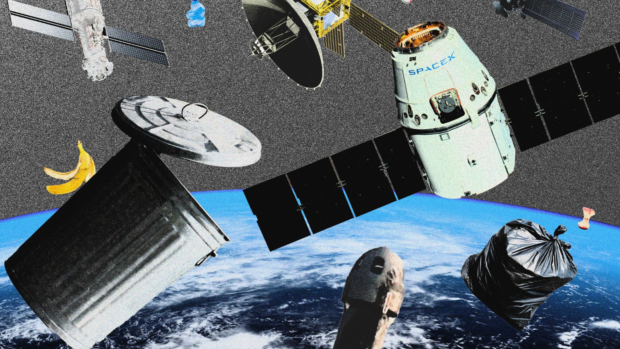Space missions often evoke images of astronauts floating in the vastness of space and rockets zooming towards distant planets. However, what we often overlook is the accumulation of garbage that we leave behind in outer space. Surprisingly, according to The Conversation news outlet, we have already amassed around 200 tons of space junk, and the problem is only getting worse as nobody seems interested in cleaning it up. It’s easy to disregard the Moon as a part of Earth, which leads to a lack of concern about what we do on its surface. However, it’s important to recognize that our planet’s oldest satellite has a significant impact on global conditions, such as the ebb and flow of tides worldwide. Furthermore, the space debris is dangerously close to forming larger chunks that could potentially crash into the Earth without any warning. Let’s explore this otherworldly issue in more depth by examining the amount of space trash we have accumulated and the objects within it. Moreover, I will discuss the risks associated with excessive space junk and shed light on why nobody wants to take responsibility for its proper disposal.
When it comes to space junk, recent space missions have undoubtedly been remarkable milestones for humanity. However, the increased activity has left a significant amount of debris both on the Moon and in Earth’s orbit. For instance, The Conversation reveals that we have left behind over 50 rocket boosters and various miscellaneous objects in outer space, totaling a staggering 200 tons. The Royal Museums Greenwich even provides a list of items discovered on the Moon, including 96 bags of human waste, a family picture featuring Apollo 16 astronaut Charles Duke, numerous flags, the ashes of US geologist Gene Shoemaker, a fascinating art gallery called the “Moon Museum” featuring miniature works of art from renowned artists like Andy Warhol and Claes Oldenburg, and the poignant “Fallen Astronaut” aluminum sculpture by Belgian artist Paul Van Hoeydonck. Additionally, there are moon buggies, other lunar equipment, golf balls, a hammer, and even a feather.
In Earth’s orbit, the clutter is equally concerning, with approximately 23,000 objects larger than four inches or 10 cm, and a staggering 100 million pieces of debris larger than 0.04 inches or 1 mm. However, what’s alarming is that there is no centralized authority responsible for cleaning up this mess.
Now, let’s delve into the risks associated with space junk. In the Disney movie “WALL-E,” there is a scene that vividly portrays the dangers of space debris. The film shows the robot protagonist latching onto Eve’s spacecraft, resulting in a catastrophic collision with multiple satellites and revealing Earth’s atmosphere covered in near-orbit garbage. In reality, if our satellites and rockets were to collide with space trash, they would most likely be destroyed. As debris gains momentum, it can reach speeds of around 15,000 mph or 24,140 kph, which is ten times faster than a bullet. This is because, according to Isaac Newton’s first law of motion, an object will continue moving in its current state until acted upon by an external force. In the vacuum of outer space, with minimal obstacles, objects can continue moving and accelerate over time. The Conversation warns that even a minuscule paint fleck can gain enough speed to puncture spacesuits or damage sensitive electronics.
In 1978, NASA scientist Donald Kessler introduced the concept of the Kessler syndrome, which describes the dangerous scenario of multiple pieces of space debris colliding and aggregating, rendering it nearly impossible to have satellites safely orbiting the Earth. Jonathan McDowell, speaking to Space.com, expressed the gravity of the situation, likening it to an interstate highway during rush hour in a snowstorm, with everyone driving dangerously fast.
Moreover, space junk poses a threat to future Moon missions. Unlike our planet, the Moon lacks a protective atmosphere that would burn up interstellar debris upon entry. Therefore, piles of debris could potentially crash into future lunar infrastructure and harm astronauts. The lack of globally accepted responsibilities means that no one is held accountable for cleaning up the Moon or our orbit. It’s difficult to assign this task to any particular nation when these objects are thousands of miles away from us.
If we do not address and rectify the issue of space debris, it could impede future space expeditions altogether. It is crucial that we find ways to minimize waste during space missions and devise proper strategies for disposing of space junk. After all, countries like the United States have plans to build lunar infrastructure and enable humans to live on the Moon. It’s about time we take responsibility and ensure that the cosmic environment is free from the hazards of excessive space trash.
Denial of responsibility! VigourTimes is an automatic aggregator of Global media. In each content, the hyperlink to the primary source is specified. All trademarks belong to their rightful owners, and all materials to their authors. For any complaint, please reach us at – [email protected]. We will take necessary action within 24 hours.


